Purchasing Management Report: Supplier Selection and Cost Analysis
VerifiedAdded on 2023/03/30
|15
|2404
|331
Report
AI Summary
This report provides a detailed analysis of purchasing management, focusing on supplier selection, cost analysis, and the implementation of IT solutions within the context of a case study of NTUC Fairprice, a major supermarket chain in Singapore. The report begins with an introduction to the company, its mission, and its competitors, setting the stage for an examination of supplier selection criteria and evaluation methods, including the linear averaging method. It then delves into the comparison of single versus multiple sourcing strategies and applies the Peter Kraljic model of risk-value to strategic purchasing decisions. Furthermore, the report explores cost analysis techniques such as total cost of ownership (TCO) and activity-based costing (ABC), and it concludes with a discussion of the role of IT in purchasing, including the use of Electronic Data Interchange (EDI) and supplier portals to streamline operations. The report emphasizes the importance of these elements in effective purchasing management for the company.
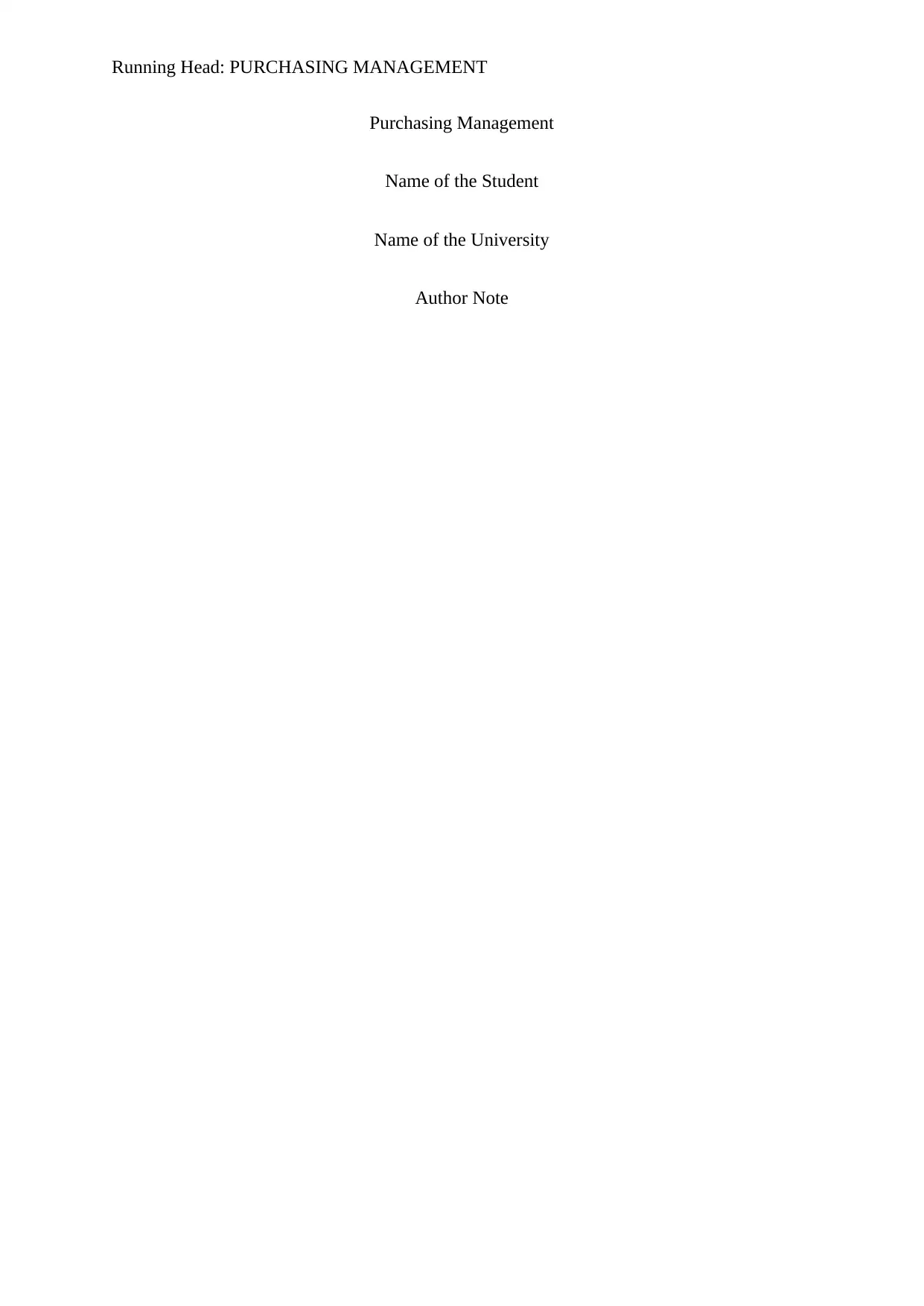
Running Head: PURCHASING MANAGEMENT
Purchasing Management
Name of the Student
Name of the University
Author Note
Purchasing Management
Name of the Student
Name of the University
Author Note
Paraphrase This Document
Need a fresh take? Get an instant paraphrase of this document with our AI Paraphraser
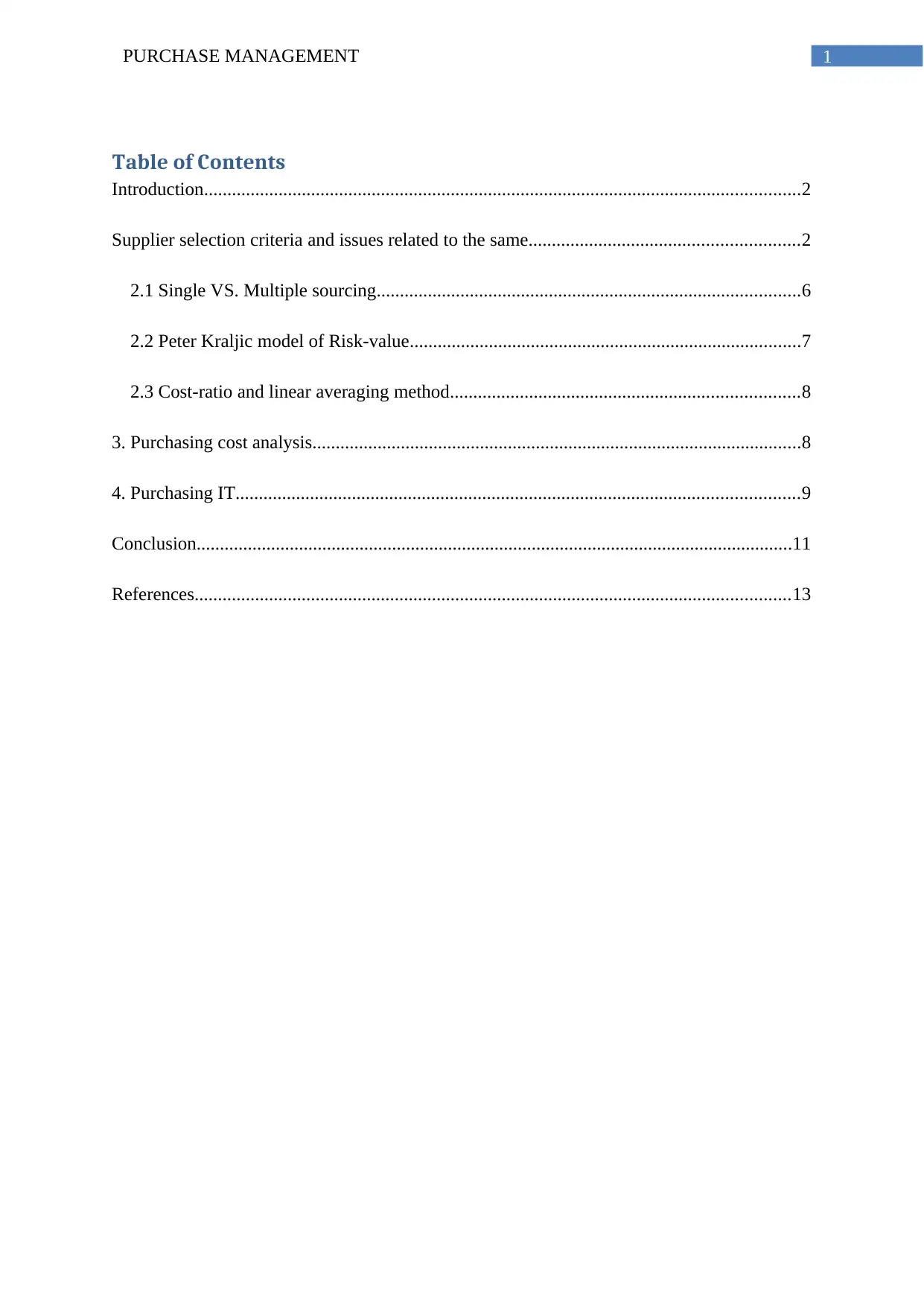
1PURCHASE MANAGEMENT
Table of Contents
Introduction................................................................................................................................2
Supplier selection criteria and issues related to the same..........................................................2
2.1 Single VS. Multiple sourcing...........................................................................................6
2.2 Peter Kraljic model of Risk-value....................................................................................7
2.3 Cost-ratio and linear averaging method...........................................................................8
3. Purchasing cost analysis.........................................................................................................8
4. Purchasing IT.........................................................................................................................9
Conclusion................................................................................................................................11
References................................................................................................................................13
Table of Contents
Introduction................................................................................................................................2
Supplier selection criteria and issues related to the same..........................................................2
2.1 Single VS. Multiple sourcing...........................................................................................6
2.2 Peter Kraljic model of Risk-value....................................................................................7
2.3 Cost-ratio and linear averaging method...........................................................................8
3. Purchasing cost analysis.........................................................................................................8
4. Purchasing IT.........................................................................................................................9
Conclusion................................................................................................................................11
References................................................................................................................................13
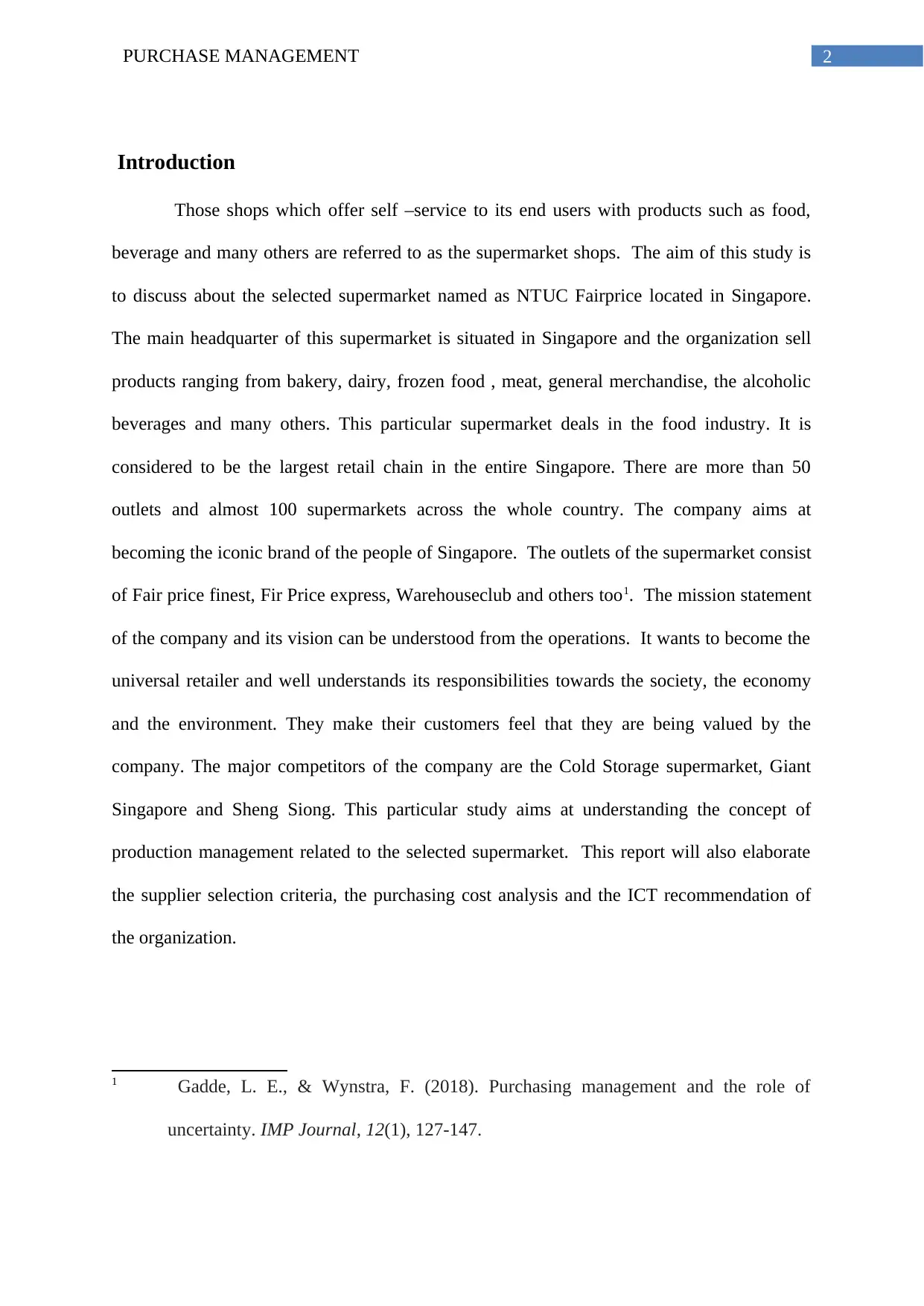
2PURCHASE MANAGEMENT
Introduction
Those shops which offer self –service to its end users with products such as food,
beverage and many others are referred to as the supermarket shops. The aim of this study is
to discuss about the selected supermarket named as NTUC Fairprice located in Singapore.
The main headquarter of this supermarket is situated in Singapore and the organization sell
products ranging from bakery, dairy, frozen food , meat, general merchandise, the alcoholic
beverages and many others. This particular supermarket deals in the food industry. It is
considered to be the largest retail chain in the entire Singapore. There are more than 50
outlets and almost 100 supermarkets across the whole country. The company aims at
becoming the iconic brand of the people of Singapore. The outlets of the supermarket consist
of Fair price finest, Fir Price express, Warehouseclub and others too1. The mission statement
of the company and its vision can be understood from the operations. It wants to become the
universal retailer and well understands its responsibilities towards the society, the economy
and the environment. They make their customers feel that they are being valued by the
company. The major competitors of the company are the Cold Storage supermarket, Giant
Singapore and Sheng Siong. This particular study aims at understanding the concept of
production management related to the selected supermarket. This report will also elaborate
the supplier selection criteria, the purchasing cost analysis and the ICT recommendation of
the organization.
1 Gadde, L. E., & Wynstra, F. (2018). Purchasing management and the role of
uncertainty. IMP Journal, 12(1), 127-147.
Introduction
Those shops which offer self –service to its end users with products such as food,
beverage and many others are referred to as the supermarket shops. The aim of this study is
to discuss about the selected supermarket named as NTUC Fairprice located in Singapore.
The main headquarter of this supermarket is situated in Singapore and the organization sell
products ranging from bakery, dairy, frozen food , meat, general merchandise, the alcoholic
beverages and many others. This particular supermarket deals in the food industry. It is
considered to be the largest retail chain in the entire Singapore. There are more than 50
outlets and almost 100 supermarkets across the whole country. The company aims at
becoming the iconic brand of the people of Singapore. The outlets of the supermarket consist
of Fair price finest, Fir Price express, Warehouseclub and others too1. The mission statement
of the company and its vision can be understood from the operations. It wants to become the
universal retailer and well understands its responsibilities towards the society, the economy
and the environment. They make their customers feel that they are being valued by the
company. The major competitors of the company are the Cold Storage supermarket, Giant
Singapore and Sheng Siong. This particular study aims at understanding the concept of
production management related to the selected supermarket. This report will also elaborate
the supplier selection criteria, the purchasing cost analysis and the ICT recommendation of
the organization.
1 Gadde, L. E., & Wynstra, F. (2018). Purchasing management and the role of
uncertainty. IMP Journal, 12(1), 127-147.
⊘ This is a preview!⊘
Do you want full access?
Subscribe today to unlock all pages.

Trusted by 1+ million students worldwide
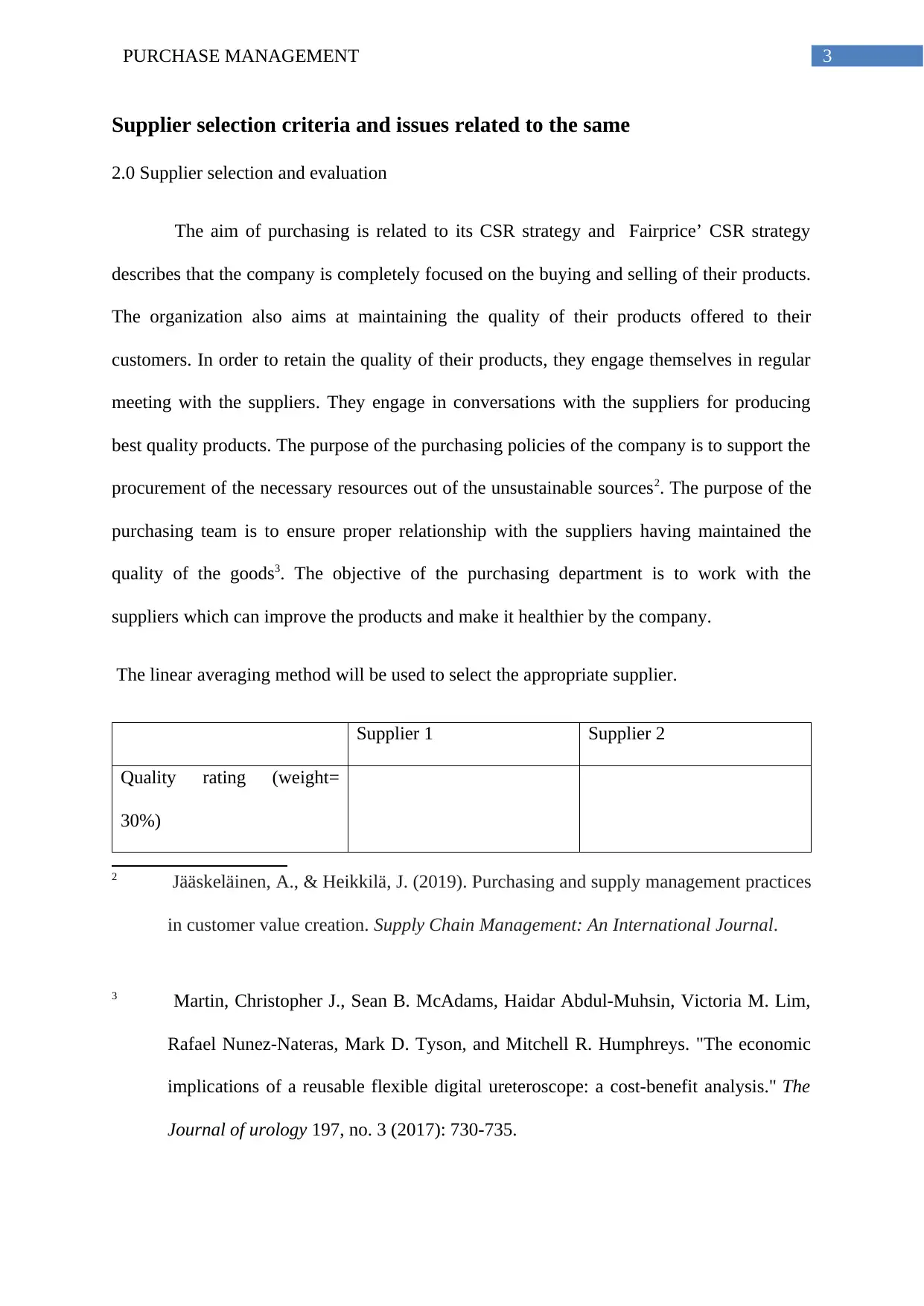
3PURCHASE MANAGEMENT
Supplier selection criteria and issues related to the same
2.0 Supplier selection and evaluation
The aim of purchasing is related to its CSR strategy and Fairprice’ CSR strategy
describes that the company is completely focused on the buying and selling of their products.
The organization also aims at maintaining the quality of their products offered to their
customers. In order to retain the quality of their products, they engage themselves in regular
meeting with the suppliers. They engage in conversations with the suppliers for producing
best quality products. The purpose of the purchasing policies of the company is to support the
procurement of the necessary resources out of the unsustainable sources2. The purpose of the
purchasing team is to ensure proper relationship with the suppliers having maintained the
quality of the goods3. The objective of the purchasing department is to work with the
suppliers which can improve the products and make it healthier by the company.
The linear averaging method will be used to select the appropriate supplier.
Supplier 1 Supplier 2
Quality rating (weight=
30%)
2 Jääskeläinen, A., & Heikkilä, J. (2019). Purchasing and supply management practices
in customer value creation. Supply Chain Management: An International Journal.
3 Martin, Christopher J., Sean B. McAdams, Haidar Abdul-Muhsin, Victoria M. Lim,
Rafael Nunez-Nateras, Mark D. Tyson, and Mitchell R. Humphreys. "The economic
implications of a reusable flexible digital ureteroscope: a cost-benefit analysis." The
Journal of urology 197, no. 3 (2017): 730-735.
Supplier selection criteria and issues related to the same
2.0 Supplier selection and evaluation
The aim of purchasing is related to its CSR strategy and Fairprice’ CSR strategy
describes that the company is completely focused on the buying and selling of their products.
The organization also aims at maintaining the quality of their products offered to their
customers. In order to retain the quality of their products, they engage themselves in regular
meeting with the suppliers. They engage in conversations with the suppliers for producing
best quality products. The purpose of the purchasing policies of the company is to support the
procurement of the necessary resources out of the unsustainable sources2. The purpose of the
purchasing team is to ensure proper relationship with the suppliers having maintained the
quality of the goods3. The objective of the purchasing department is to work with the
suppliers which can improve the products and make it healthier by the company.
The linear averaging method will be used to select the appropriate supplier.
Supplier 1 Supplier 2
Quality rating (weight=
30%)
2 Jääskeläinen, A., & Heikkilä, J. (2019). Purchasing and supply management practices
in customer value creation. Supply Chain Management: An International Journal.
3 Martin, Christopher J., Sean B. McAdams, Haidar Abdul-Muhsin, Victoria M. Lim,
Rafael Nunez-Nateras, Mark D. Tyson, and Mitchell R. Humphreys. "The economic
implications of a reusable flexible digital ureteroscope: a cost-benefit analysis." The
Journal of urology 197, no. 3 (2017): 730-735.
Paraphrase This Document
Need a fresh take? Get an instant paraphrase of this document with our AI Paraphraser
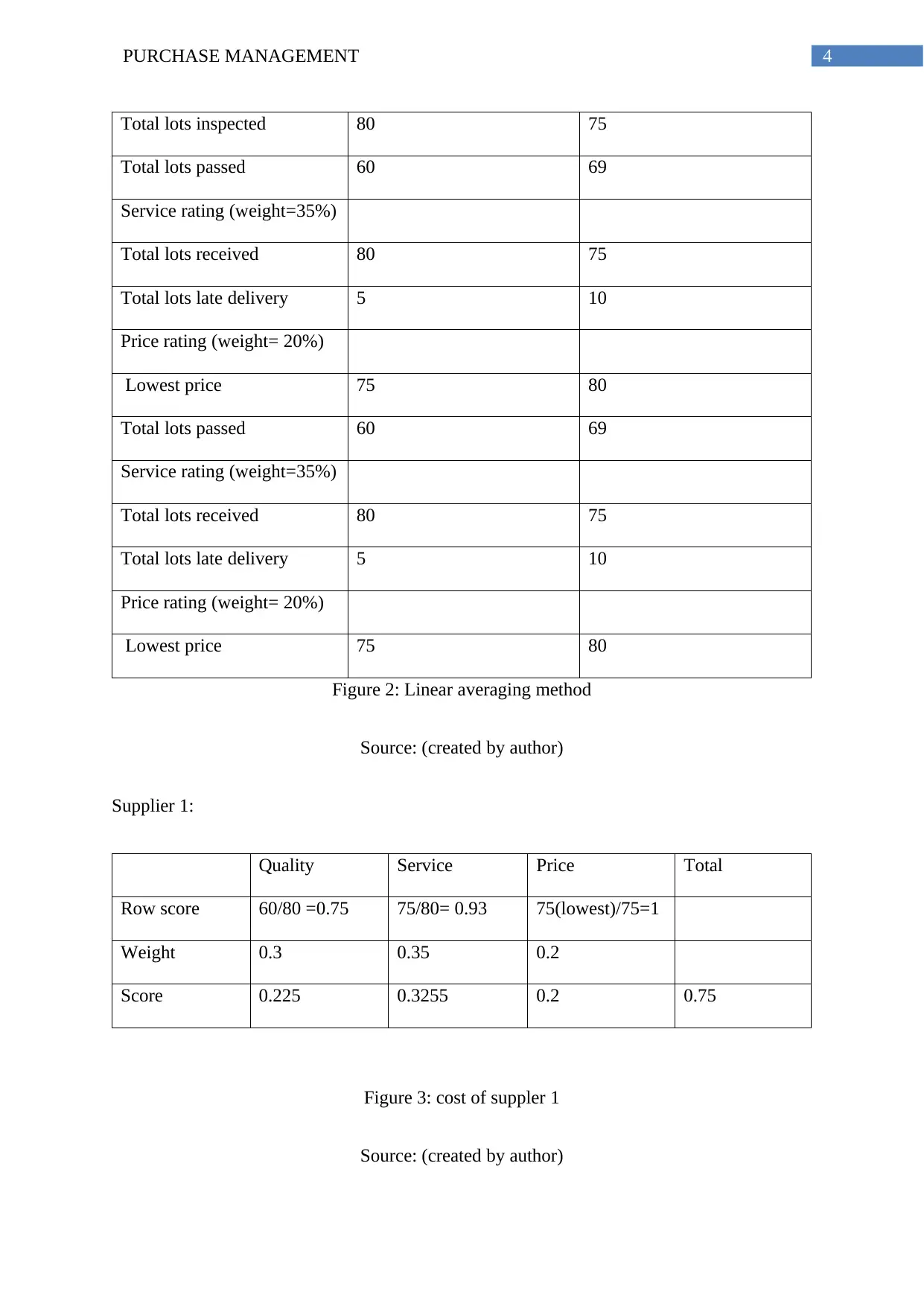
4PURCHASE MANAGEMENT
Total lots inspected 80 75
Total lots passed 60 69
Service rating (weight=35%)
Total lots received 80 75
Total lots late delivery 5 10
Price rating (weight= 20%)
Lowest price 75 80
Total lots passed 60 69
Service rating (weight=35%)
Total lots received 80 75
Total lots late delivery 5 10
Price rating (weight= 20%)
Lowest price 75 80
Figure 2: Linear averaging method
Source: (created by author)
Supplier 1:
Quality Service Price Total
Row score 60/80 =0.75 75/80= 0.93 75(lowest)/75=1
Weight 0.3 0.35 0.2
Score 0.225 0.3255 0.2 0.75
Figure 3: cost of suppler 1
Source: (created by author)
Total lots inspected 80 75
Total lots passed 60 69
Service rating (weight=35%)
Total lots received 80 75
Total lots late delivery 5 10
Price rating (weight= 20%)
Lowest price 75 80
Total lots passed 60 69
Service rating (weight=35%)
Total lots received 80 75
Total lots late delivery 5 10
Price rating (weight= 20%)
Lowest price 75 80
Figure 2: Linear averaging method
Source: (created by author)
Supplier 1:
Quality Service Price Total
Row score 60/80 =0.75 75/80= 0.93 75(lowest)/75=1
Weight 0.3 0.35 0.2
Score 0.225 0.3255 0.2 0.75
Figure 3: cost of suppler 1
Source: (created by author)
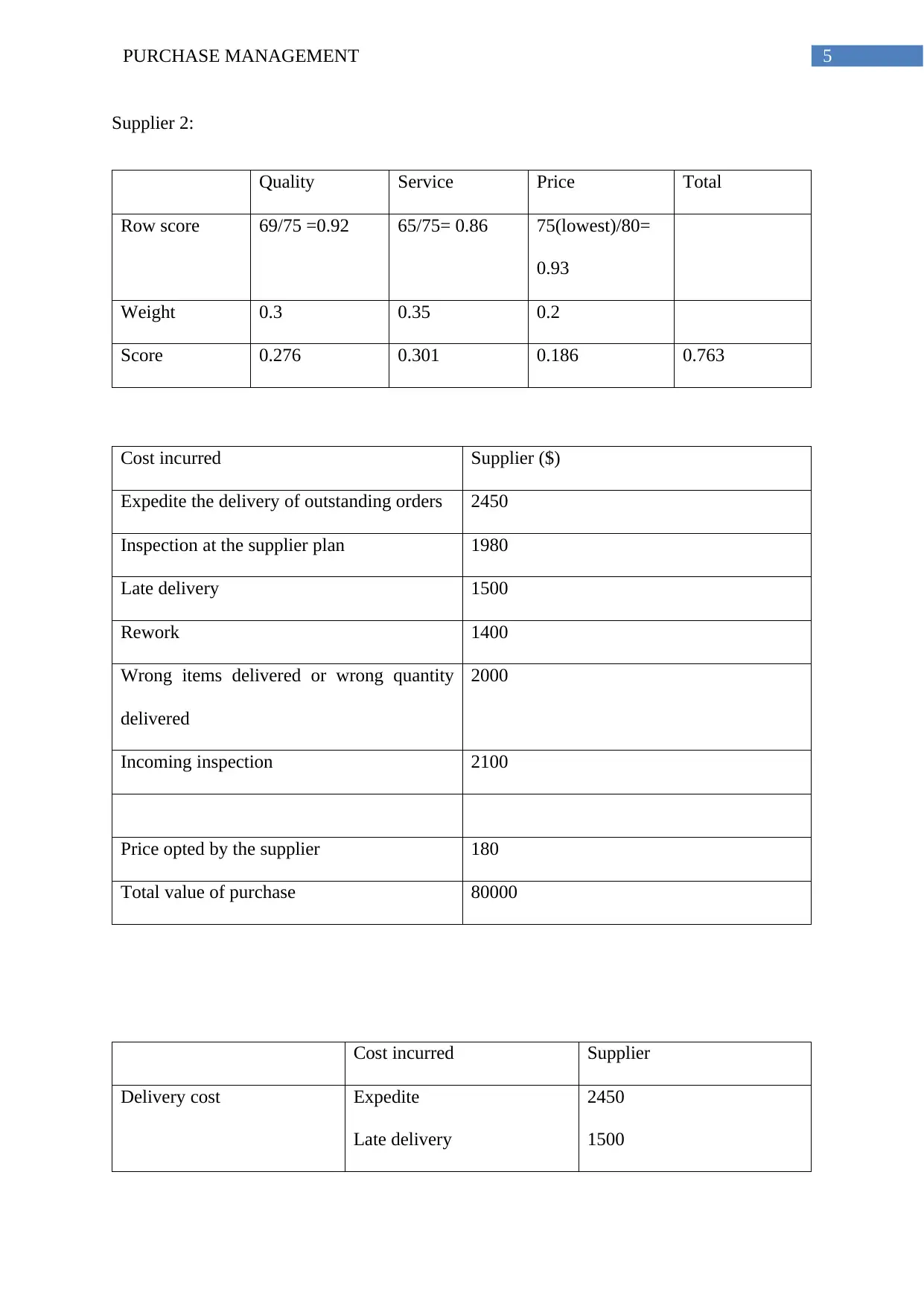
5PURCHASE MANAGEMENT
Supplier 2:
Quality Service Price Total
Row score 69/75 =0.92 65/75= 0.86 75(lowest)/80=
0.93
Weight 0.3 0.35 0.2
Score 0.276 0.301 0.186 0.763
Cost incurred Supplier ($)
Expedite the delivery of outstanding orders 2450
Inspection at the supplier plan 1980
Late delivery 1500
Rework 1400
Wrong items delivered or wrong quantity
delivered
2000
Incoming inspection 2100
Price opted by the supplier 180
Total value of purchase 80000
Cost incurred Supplier
Delivery cost Expedite
Late delivery
2450
1500
Supplier 2:
Quality Service Price Total
Row score 69/75 =0.92 65/75= 0.86 75(lowest)/80=
0.93
Weight 0.3 0.35 0.2
Score 0.276 0.301 0.186 0.763
Cost incurred Supplier ($)
Expedite the delivery of outstanding orders 2450
Inspection at the supplier plan 1980
Late delivery 1500
Rework 1400
Wrong items delivered or wrong quantity
delivered
2000
Incoming inspection 2100
Price opted by the supplier 180
Total value of purchase 80000
Cost incurred Supplier
Delivery cost Expedite
Late delivery
2450
1500
⊘ This is a preview!⊘
Do you want full access?
Subscribe today to unlock all pages.

Trusted by 1+ million students worldwide
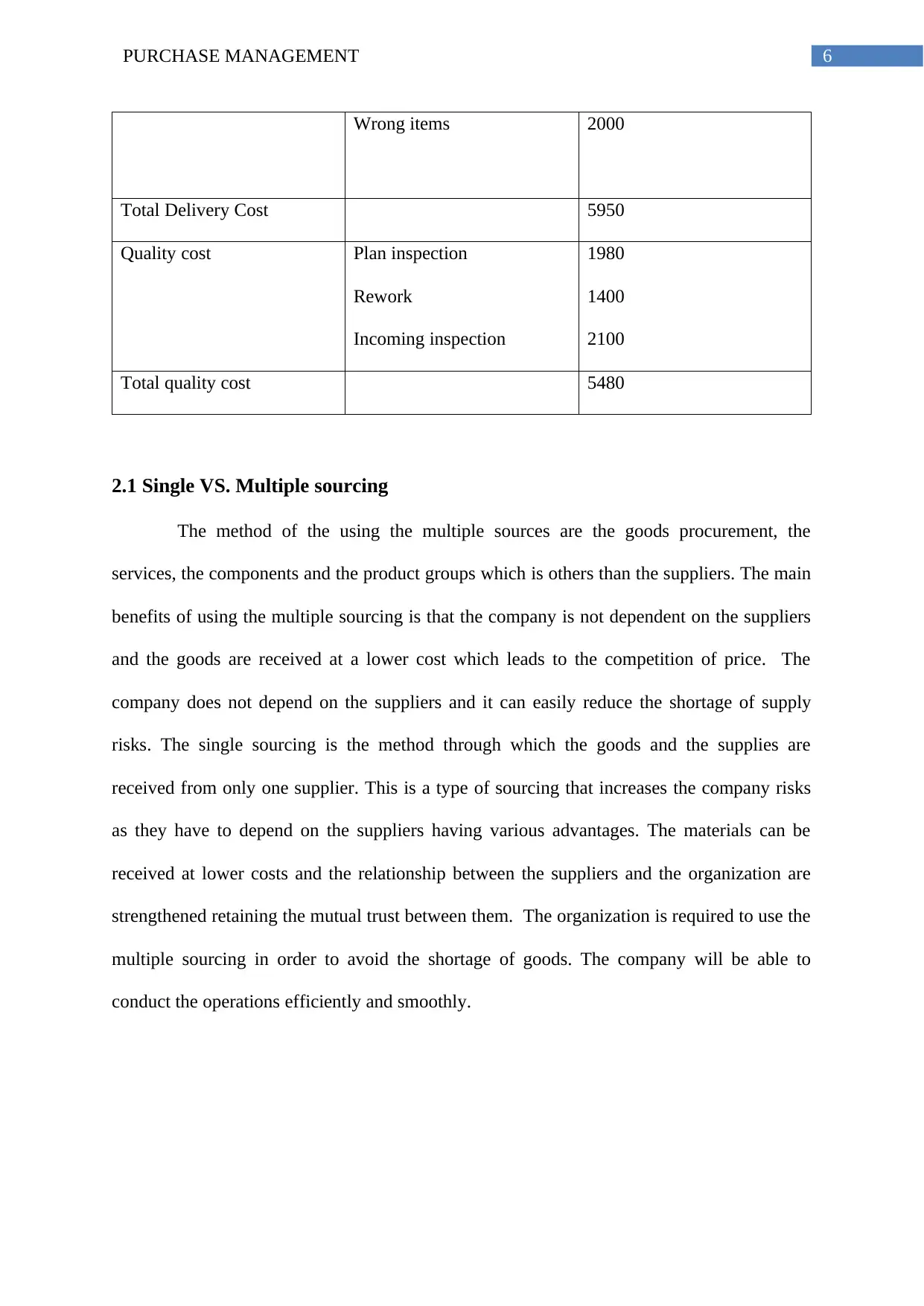
6PURCHASE MANAGEMENT
Wrong items 2000
Total Delivery Cost 5950
Quality cost Plan inspection
Rework
Incoming inspection
1980
1400
2100
Total quality cost 5480
2.1 Single VS. Multiple sourcing
The method of the using the multiple sources are the goods procurement, the
services, the components and the product groups which is others than the suppliers. The main
benefits of using the multiple sourcing is that the company is not dependent on the suppliers
and the goods are received at a lower cost which leads to the competition of price. The
company does not depend on the suppliers and it can easily reduce the shortage of supply
risks. The single sourcing is the method through which the goods and the supplies are
received from only one supplier. This is a type of sourcing that increases the company risks
as they have to depend on the suppliers having various advantages. The materials can be
received at lower costs and the relationship between the suppliers and the organization are
strengthened retaining the mutual trust between them. The organization is required to use the
multiple sourcing in order to avoid the shortage of goods. The company will be able to
conduct the operations efficiently and smoothly.
Wrong items 2000
Total Delivery Cost 5950
Quality cost Plan inspection
Rework
Incoming inspection
1980
1400
2100
Total quality cost 5480
2.1 Single VS. Multiple sourcing
The method of the using the multiple sources are the goods procurement, the
services, the components and the product groups which is others than the suppliers. The main
benefits of using the multiple sourcing is that the company is not dependent on the suppliers
and the goods are received at a lower cost which leads to the competition of price. The
company does not depend on the suppliers and it can easily reduce the shortage of supply
risks. The single sourcing is the method through which the goods and the supplies are
received from only one supplier. This is a type of sourcing that increases the company risks
as they have to depend on the suppliers having various advantages. The materials can be
received at lower costs and the relationship between the suppliers and the organization are
strengthened retaining the mutual trust between them. The organization is required to use the
multiple sourcing in order to avoid the shortage of goods. The company will be able to
conduct the operations efficiently and smoothly.
Paraphrase This Document
Need a fresh take? Get an instant paraphrase of this document with our AI Paraphraser
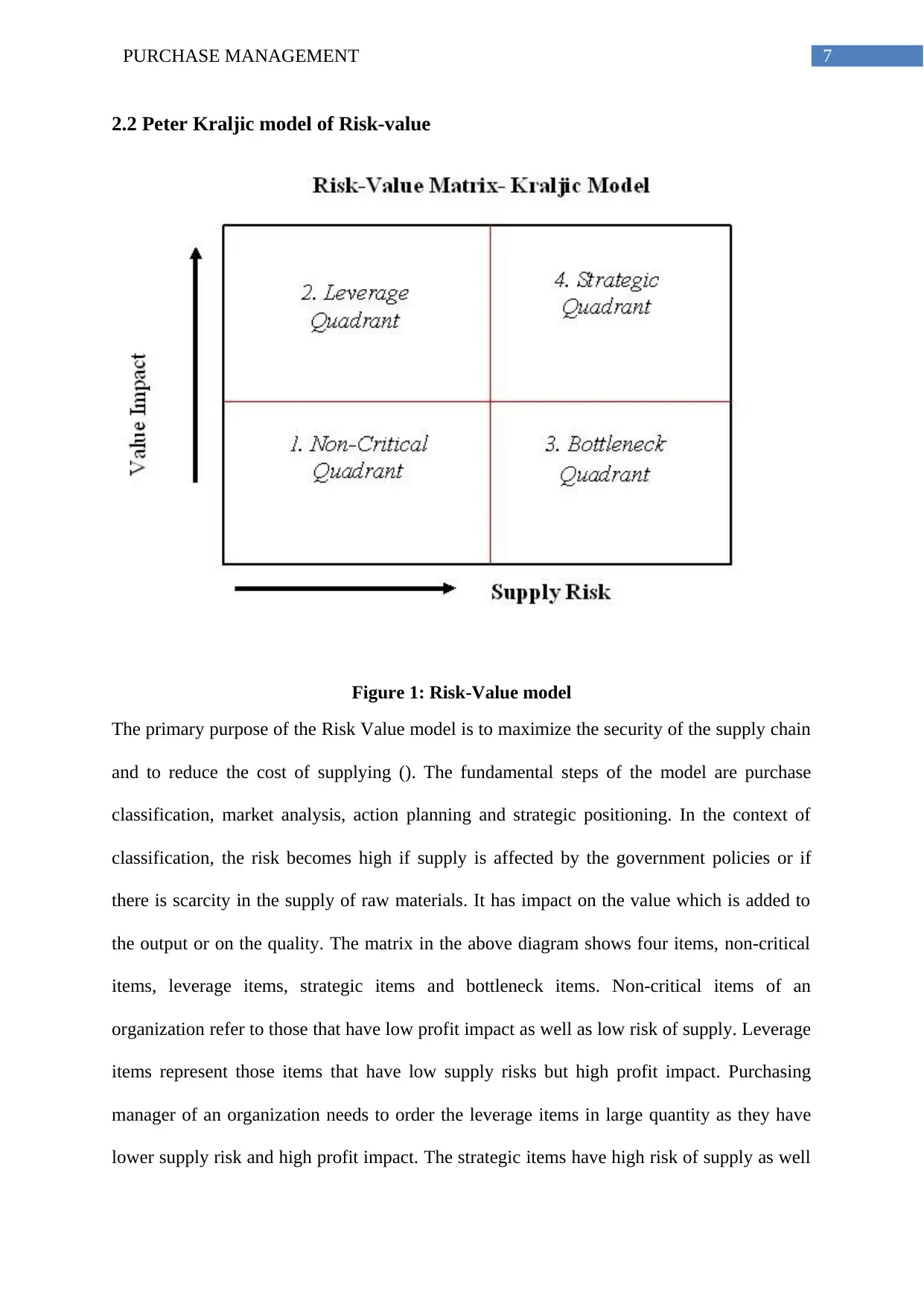
7PURCHASE MANAGEMENT
2.2 Peter Kraljic model of Risk-value
Figure 1: Risk-Value model
The primary purpose of the Risk Value model is to maximize the security of the supply chain
and to reduce the cost of supplying (). The fundamental steps of the model are purchase
classification, market analysis, action planning and strategic positioning. In the context of
classification, the risk becomes high if supply is affected by the government policies or if
there is scarcity in the supply of raw materials. It has impact on the value which is added to
the output or on the quality. The matrix in the above diagram shows four items, non-critical
items, leverage items, strategic items and bottleneck items. Non-critical items of an
organization refer to those that have low profit impact as well as low risk of supply. Leverage
items represent those items that have low supply risks but high profit impact. Purchasing
manager of an organization needs to order the leverage items in large quantity as they have
lower supply risk and high profit impact. The strategic items have high risk of supply as well
2.2 Peter Kraljic model of Risk-value
Figure 1: Risk-Value model
The primary purpose of the Risk Value model is to maximize the security of the supply chain
and to reduce the cost of supplying (). The fundamental steps of the model are purchase
classification, market analysis, action planning and strategic positioning. In the context of
classification, the risk becomes high if supply is affected by the government policies or if
there is scarcity in the supply of raw materials. It has impact on the value which is added to
the output or on the quality. The matrix in the above diagram shows four items, non-critical
items, leverage items, strategic items and bottleneck items. Non-critical items of an
organization refer to those that have low profit impact as well as low risk of supply. Leverage
items represent those items that have low supply risks but high profit impact. Purchasing
manager of an organization needs to order the leverage items in large quantity as they have
lower supply risk and high profit impact. The strategic items have high risk of supply as well
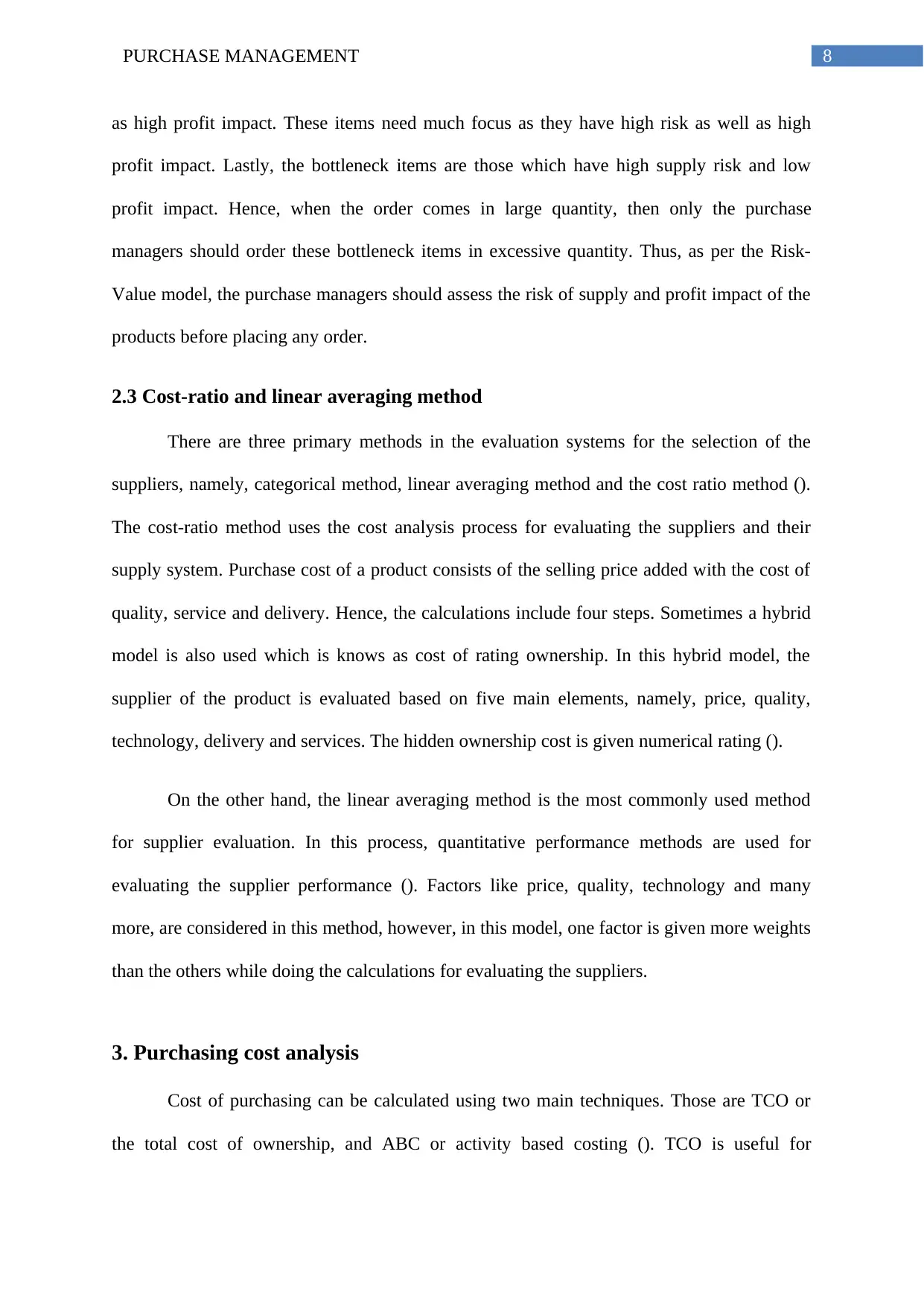
8PURCHASE MANAGEMENT
as high profit impact. These items need much focus as they have high risk as well as high
profit impact. Lastly, the bottleneck items are those which have high supply risk and low
profit impact. Hence, when the order comes in large quantity, then only the purchase
managers should order these bottleneck items in excessive quantity. Thus, as per the Risk-
Value model, the purchase managers should assess the risk of supply and profit impact of the
products before placing any order.
2.3 Cost-ratio and linear averaging method
There are three primary methods in the evaluation systems for the selection of the
suppliers, namely, categorical method, linear averaging method and the cost ratio method ().
The cost-ratio method uses the cost analysis process for evaluating the suppliers and their
supply system. Purchase cost of a product consists of the selling price added with the cost of
quality, service and delivery. Hence, the calculations include four steps. Sometimes a hybrid
model is also used which is knows as cost of rating ownership. In this hybrid model, the
supplier of the product is evaluated based on five main elements, namely, price, quality,
technology, delivery and services. The hidden ownership cost is given numerical rating ().
On the other hand, the linear averaging method is the most commonly used method
for supplier evaluation. In this process, quantitative performance methods are used for
evaluating the supplier performance (). Factors like price, quality, technology and many
more, are considered in this method, however, in this model, one factor is given more weights
than the others while doing the calculations for evaluating the suppliers.
3. Purchasing cost analysis
Cost of purchasing can be calculated using two main techniques. Those are TCO or
the total cost of ownership, and ABC or activity based costing (). TCO is useful for
as high profit impact. These items need much focus as they have high risk as well as high
profit impact. Lastly, the bottleneck items are those which have high supply risk and low
profit impact. Hence, when the order comes in large quantity, then only the purchase
managers should order these bottleneck items in excessive quantity. Thus, as per the Risk-
Value model, the purchase managers should assess the risk of supply and profit impact of the
products before placing any order.
2.3 Cost-ratio and linear averaging method
There are three primary methods in the evaluation systems for the selection of the
suppliers, namely, categorical method, linear averaging method and the cost ratio method ().
The cost-ratio method uses the cost analysis process for evaluating the suppliers and their
supply system. Purchase cost of a product consists of the selling price added with the cost of
quality, service and delivery. Hence, the calculations include four steps. Sometimes a hybrid
model is also used which is knows as cost of rating ownership. In this hybrid model, the
supplier of the product is evaluated based on five main elements, namely, price, quality,
technology, delivery and services. The hidden ownership cost is given numerical rating ().
On the other hand, the linear averaging method is the most commonly used method
for supplier evaluation. In this process, quantitative performance methods are used for
evaluating the supplier performance (). Factors like price, quality, technology and many
more, are considered in this method, however, in this model, one factor is given more weights
than the others while doing the calculations for evaluating the suppliers.
3. Purchasing cost analysis
Cost of purchasing can be calculated using two main techniques. Those are TCO or
the total cost of ownership, and ABC or activity based costing (). TCO is useful for
⊘ This is a preview!⊘
Do you want full access?
Subscribe today to unlock all pages.

Trusted by 1+ million students worldwide
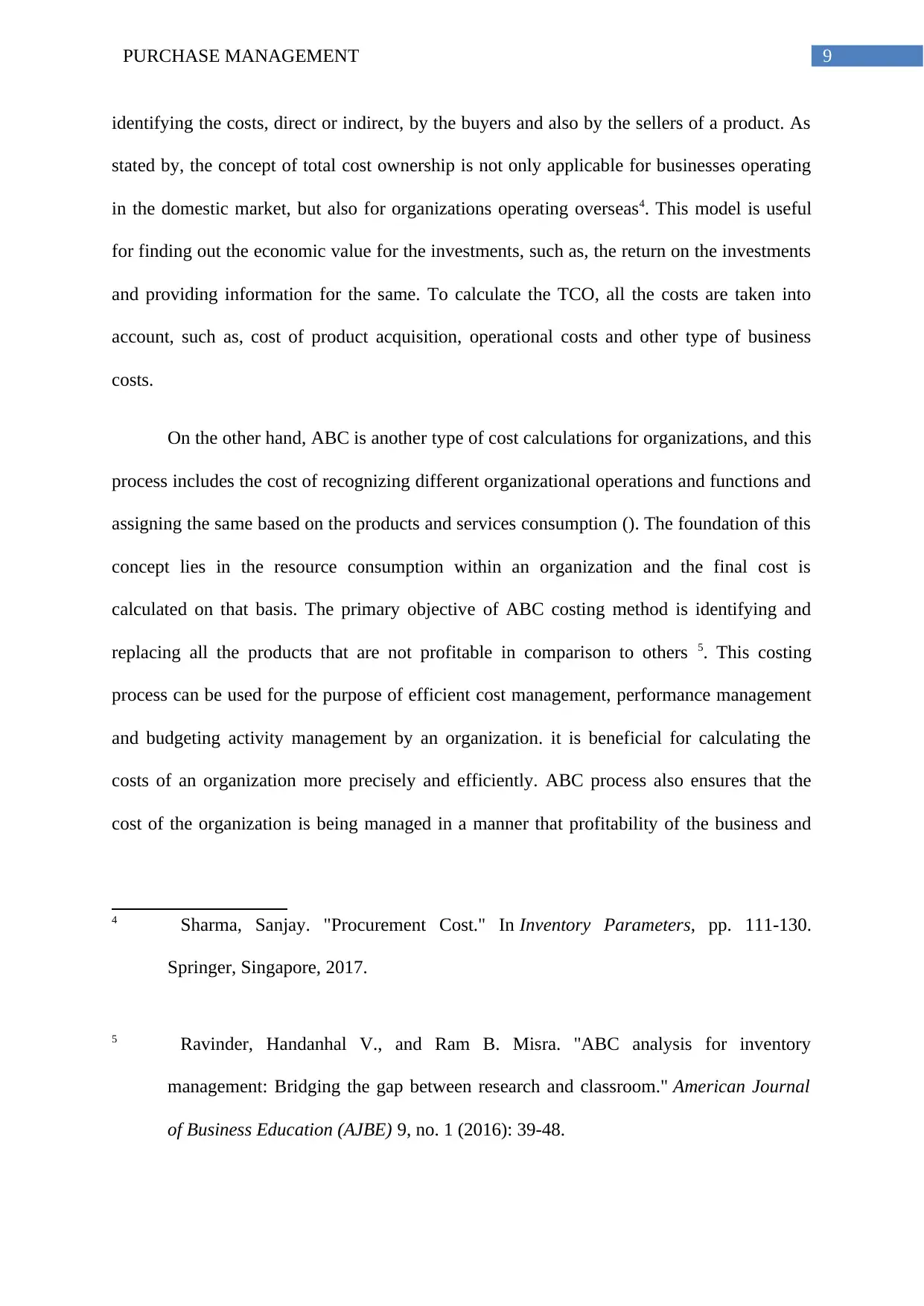
9PURCHASE MANAGEMENT
identifying the costs, direct or indirect, by the buyers and also by the sellers of a product. As
stated by, the concept of total cost ownership is not only applicable for businesses operating
in the domestic market, but also for organizations operating overseas4. This model is useful
for finding out the economic value for the investments, such as, the return on the investments
and providing information for the same. To calculate the TCO, all the costs are taken into
account, such as, cost of product acquisition, operational costs and other type of business
costs.
On the other hand, ABC is another type of cost calculations for organizations, and this
process includes the cost of recognizing different organizational operations and functions and
assigning the same based on the products and services consumption (). The foundation of this
concept lies in the resource consumption within an organization and the final cost is
calculated on that basis. The primary objective of ABC costing method is identifying and
replacing all the products that are not profitable in comparison to others 5. This costing
process can be used for the purpose of efficient cost management, performance management
and budgeting activity management by an organization. it is beneficial for calculating the
costs of an organization more precisely and efficiently. ABC process also ensures that the
cost of the organization is being managed in a manner that profitability of the business and
4 Sharma, Sanjay. "Procurement Cost." In Inventory Parameters, pp. 111-130.
Springer, Singapore, 2017.
5 Ravinder, Handanhal V., and Ram B. Misra. "ABC analysis for inventory
management: Bridging the gap between research and classroom." American Journal
of Business Education (AJBE) 9, no. 1 (2016): 39-48.
identifying the costs, direct or indirect, by the buyers and also by the sellers of a product. As
stated by, the concept of total cost ownership is not only applicable for businesses operating
in the domestic market, but also for organizations operating overseas4. This model is useful
for finding out the economic value for the investments, such as, the return on the investments
and providing information for the same. To calculate the TCO, all the costs are taken into
account, such as, cost of product acquisition, operational costs and other type of business
costs.
On the other hand, ABC is another type of cost calculations for organizations, and this
process includes the cost of recognizing different organizational operations and functions and
assigning the same based on the products and services consumption (). The foundation of this
concept lies in the resource consumption within an organization and the final cost is
calculated on that basis. The primary objective of ABC costing method is identifying and
replacing all the products that are not profitable in comparison to others 5. This costing
process can be used for the purpose of efficient cost management, performance management
and budgeting activity management by an organization. it is beneficial for calculating the
costs of an organization more precisely and efficiently. ABC process also ensures that the
cost of the organization is being managed in a manner that profitability of the business and
4 Sharma, Sanjay. "Procurement Cost." In Inventory Parameters, pp. 111-130.
Springer, Singapore, 2017.
5 Ravinder, Handanhal V., and Ram B. Misra. "ABC analysis for inventory
management: Bridging the gap between research and classroom." American Journal
of Business Education (AJBE) 9, no. 1 (2016): 39-48.
Paraphrase This Document
Need a fresh take? Get an instant paraphrase of this document with our AI Paraphraser
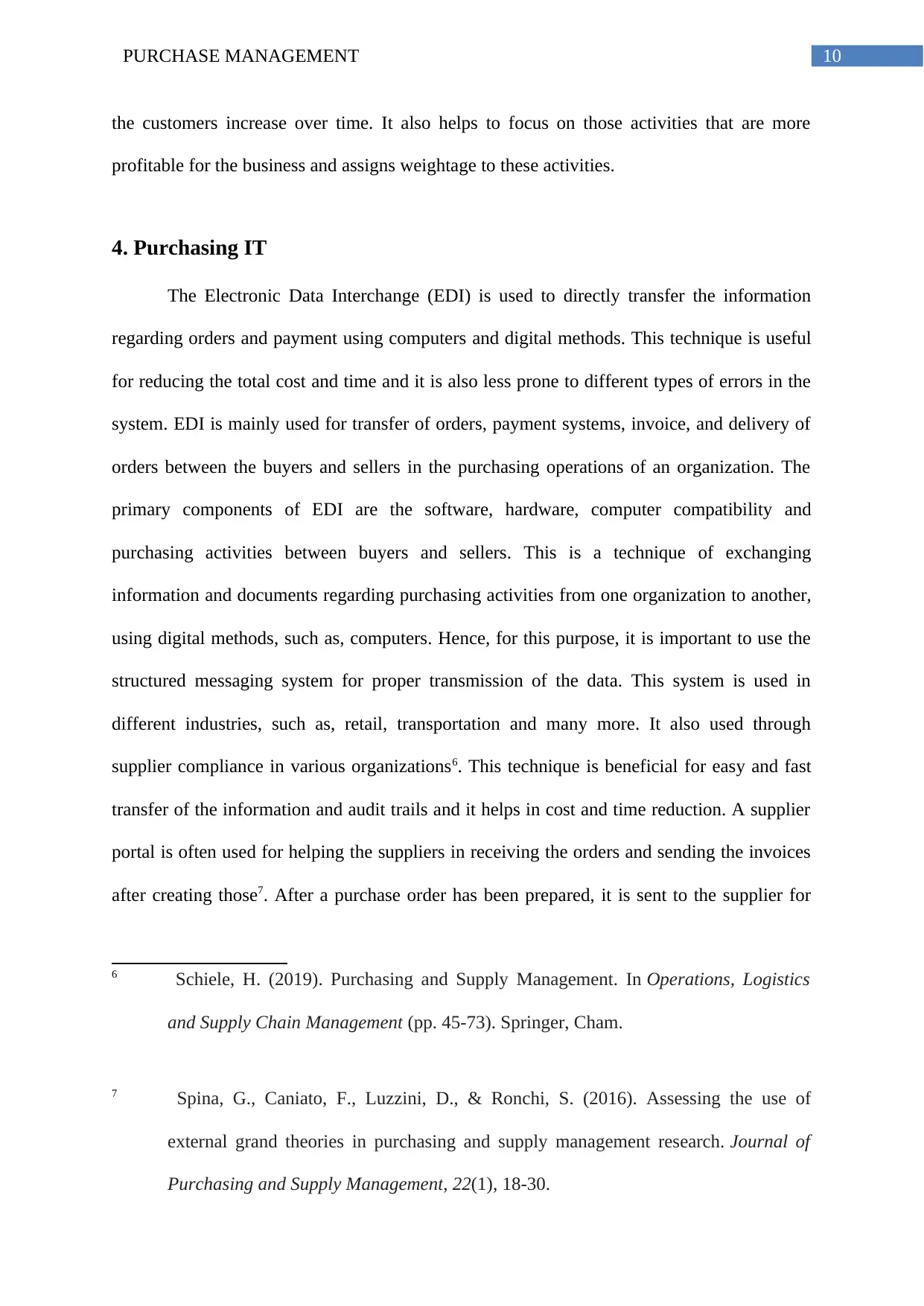
10PURCHASE MANAGEMENT
the customers increase over time. It also helps to focus on those activities that are more
profitable for the business and assigns weightage to these activities.
4. Purchasing IT
The Electronic Data Interchange (EDI) is used to directly transfer the information
regarding orders and payment using computers and digital methods. This technique is useful
for reducing the total cost and time and it is also less prone to different types of errors in the
system. EDI is mainly used for transfer of orders, payment systems, invoice, and delivery of
orders between the buyers and sellers in the purchasing operations of an organization. The
primary components of EDI are the software, hardware, computer compatibility and
purchasing activities between buyers and sellers. This is a technique of exchanging
information and documents regarding purchasing activities from one organization to another,
using digital methods, such as, computers. Hence, for this purpose, it is important to use the
structured messaging system for proper transmission of the data. This system is used in
different industries, such as, retail, transportation and many more. It also used through
supplier compliance in various organizations6. This technique is beneficial for easy and fast
transfer of the information and audit trails and it helps in cost and time reduction. A supplier
portal is often used for helping the suppliers in receiving the orders and sending the invoices
after creating those7. After a purchase order has been prepared, it is sent to the supplier for
6 Schiele, H. (2019). Purchasing and Supply Management. In Operations, Logistics
and Supply Chain Management (pp. 45-73). Springer, Cham.
7 Spina, G., Caniato, F., Luzzini, D., & Ronchi, S. (2016). Assessing the use of
external grand theories in purchasing and supply management research. Journal of
Purchasing and Supply Management, 22(1), 18-30.
the customers increase over time. It also helps to focus on those activities that are more
profitable for the business and assigns weightage to these activities.
4. Purchasing IT
The Electronic Data Interchange (EDI) is used to directly transfer the information
regarding orders and payment using computers and digital methods. This technique is useful
for reducing the total cost and time and it is also less prone to different types of errors in the
system. EDI is mainly used for transfer of orders, payment systems, invoice, and delivery of
orders between the buyers and sellers in the purchasing operations of an organization. The
primary components of EDI are the software, hardware, computer compatibility and
purchasing activities between buyers and sellers. This is a technique of exchanging
information and documents regarding purchasing activities from one organization to another,
using digital methods, such as, computers. Hence, for this purpose, it is important to use the
structured messaging system for proper transmission of the data. This system is used in
different industries, such as, retail, transportation and many more. It also used through
supplier compliance in various organizations6. This technique is beneficial for easy and fast
transfer of the information and audit trails and it helps in cost and time reduction. A supplier
portal is often used for helping the suppliers in receiving the orders and sending the invoices
after creating those7. After a purchase order has been prepared, it is sent to the supplier for
6 Schiele, H. (2019). Purchasing and Supply Management. In Operations, Logistics
and Supply Chain Management (pp. 45-73). Springer, Cham.
7 Spina, G., Caniato, F., Luzzini, D., & Ronchi, S. (2016). Assessing the use of
external grand theories in purchasing and supply management research. Journal of
Purchasing and Supply Management, 22(1), 18-30.
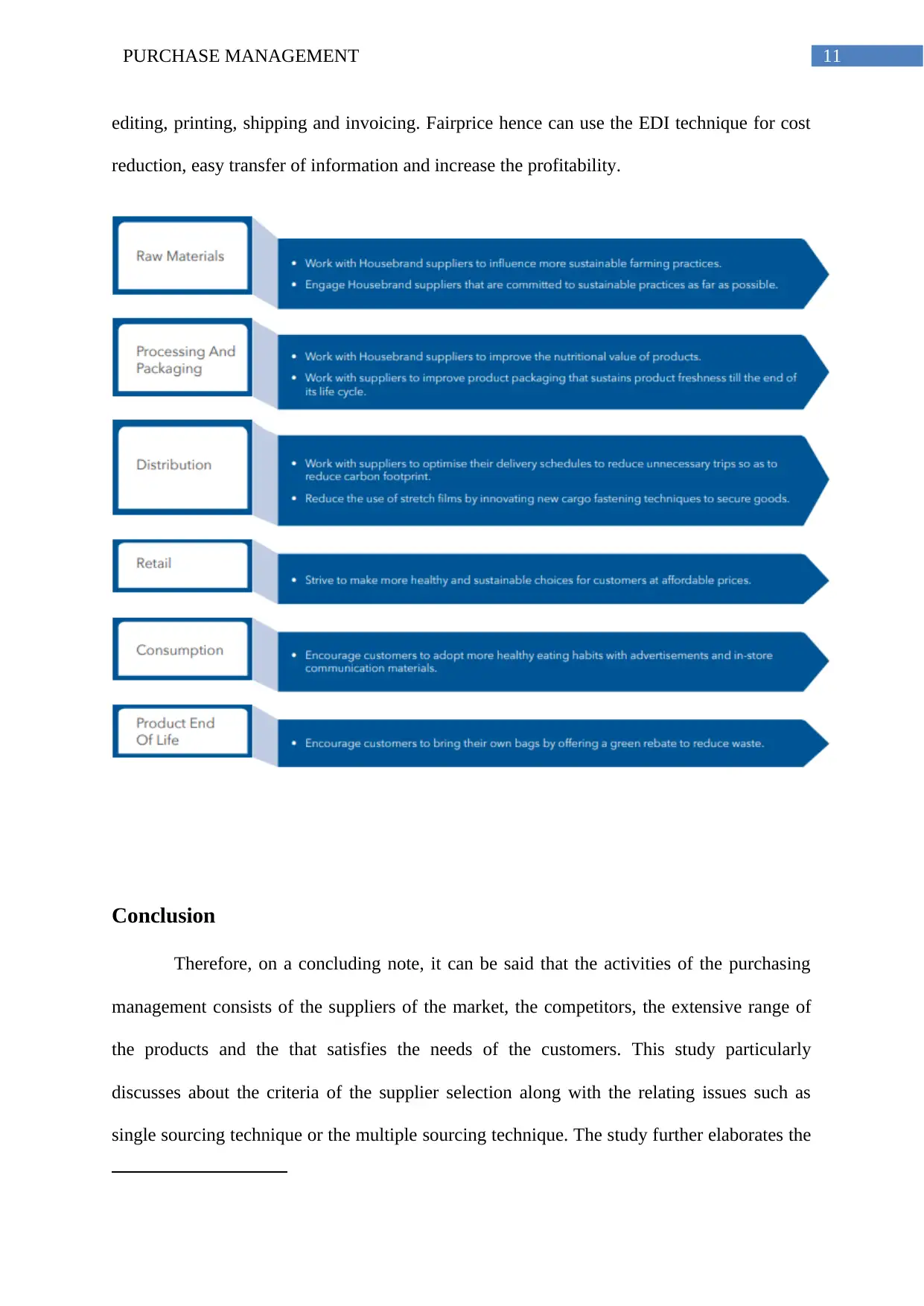
11PURCHASE MANAGEMENT
editing, printing, shipping and invoicing. Fairprice hence can use the EDI technique for cost
reduction, easy transfer of information and increase the profitability.
Conclusion
Therefore, on a concluding note, it can be said that the activities of the purchasing
management consists of the suppliers of the market, the competitors, the extensive range of
the products and the that satisfies the needs of the customers. This study particularly
discusses about the criteria of the supplier selection along with the relating issues such as
single sourcing technique or the multiple sourcing technique. The study further elaborates the
editing, printing, shipping and invoicing. Fairprice hence can use the EDI technique for cost
reduction, easy transfer of information and increase the profitability.
Conclusion
Therefore, on a concluding note, it can be said that the activities of the purchasing
management consists of the suppliers of the market, the competitors, the extensive range of
the products and the that satisfies the needs of the customers. This study particularly
discusses about the criteria of the supplier selection along with the relating issues such as
single sourcing technique or the multiple sourcing technique. The study further elaborates the
⊘ This is a preview!⊘
Do you want full access?
Subscribe today to unlock all pages.

Trusted by 1+ million students worldwide
1 out of 15
Related Documents
Your All-in-One AI-Powered Toolkit for Academic Success.
+13062052269
info@desklib.com
Available 24*7 on WhatsApp / Email
![[object Object]](/_next/static/media/star-bottom.7253800d.svg)
Unlock your academic potential
Copyright © 2020–2025 A2Z Services. All Rights Reserved. Developed and managed by ZUCOL.





